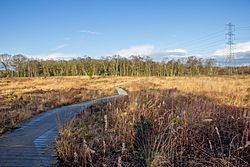Danes Moss Nature Reserve facts for kids
Quick facts for kids Danes Moss Nature Reserve |
|
|---|---|

A path across the lowland bog, leading to the wooded area
|
|
| Lua error in Module:Location_map at line 420: attempt to index field 'wikibase' (a nil value). | |
| Type | Nature reserve and SSSI |
| Location | near Macclesfield, Cheshire |
| OS grid | SJ907704 |
| Area | 13.4 hectares (33 acres) |
| Elevation | 160m |
| Operated by | Cheshire Wildlife Trust |
| Open | at all times |
Danes Moss Nature Reserve is a super special place for nature, located near Macclesfield in Cheshire, England. It's about 13.4-hectare (33-acre) big, which is like 33 football fields! This area is protected as a nature reserve and is also a Site of Special Scientific Interest (SSSI). This means it's recognized as one of the best places in the country for its wildlife and geology. The Cheshire Wildlife Trust helps look after this amazing habitat.
Discovering Danes Moss
Danes Moss is famous for being a "lowland raised bog". Imagine a giant, squishy sponge made of plants! These bogs are very rare and important habitats in the United Kingdom.
What is a Raised Bog?
A raised bog forms over thousands of years. It gets its water only from rain, not from rivers or groundwater. This makes the water very low in nutrients. Over time, dead plants, especially a type of moss called Sphagnum, build up. They create a thick layer of spongy material called peat. At Danes Moss, this peat can be up to 5 metres (16 ft) deep! That's taller than a double-decker bus. This deep peat is like a time capsule, holding clues about ancient plants and climates.
Amazing Plants of the Bog
Because the bog is so wet and has special conditions, it's home to many unique plants. You can find seven different kinds of Sphagnum moss here. These mosses are super important because they help create the bog's special environment.
Some other cool and rare plants you might spot include:
- Round-leaved sundew (Drosera rotundifolia): This plant is a mini-carnivore! It has sticky leaves that trap tiny insects for food.
- Marsh cinquefoil (Potentilla palustris): A pretty plant with reddish-purple flowers.
- Bottle sedge (Carex rostrata)
- Common lousewort (Pedicularis sylvatica)
- Fen bedstraw (Galium uliginosum)
There's even a nationally rare plant called Labrador-tea (Rhododendron tomentosum) growing here!
Incredible Insects
Danes Moss is also a buzzing hotspot for insects. It's a fantastic place to see dragonflies and damselflies. So far, eleven different types have been seen!
Keep an eye out for:
- Black darter (Sympetrum danae): This is Britain's smallest dragonfly!
- Four-spotted chaser (Libellula quadrimaculata): A common but beautiful dragonfly.
You might also spot 19 different kinds of butterflies fluttering around, including the bright green green hairstreak (Callophrys rubi).
Danes Moss Nature Reserve is a truly special place. It helps protect a rare habitat and provides a home for many amazing plants and insects. It's a great spot to visit and learn about nature!

